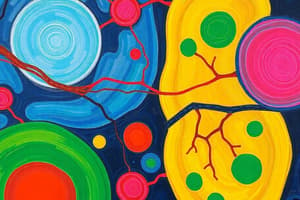Podcast
Questions and Answers
Which cell function enables muscle cells to contract and facilitate movement?
Which cell function enables muscle cells to contract and facilitate movement?
- Communication
- Secretion
- Movement (correct)
- Conductivity
What role does the extracellular matrix play in cell adhesion?
What role does the extracellular matrix play in cell adhesion?
- Facilitates nutrient absorption
- Enables muscle contraction
- Transmits electrical impulses
- Provides structural support (correct)
Which type of tissue is primarily responsible for transmitting electrical impulses?
Which type of tissue is primarily responsible for transmitting electrical impulses?
- Muscle Tissue
- Epithelial Tissue
- Nervous Tissue (correct)
- Connective Tissue
Which cellular communication method involves the direct contact of cells via gap junctions?
Which cellular communication method involves the direct contact of cells via gap junctions?
What is a key function of lysosomes in cellular excretion?
What is a key function of lysosomes in cellular excretion?
Which component is NOT a type of cell adhesion molecule?
Which component is NOT a type of cell adhesion molecule?
What happens during the mutation process?
What happens during the mutation process?
Which tissue type functions to protect, absorb, and secrete?
Which tissue type functions to protect, absorb, and secrete?
What is the primary function of mitochondria within a cell?
What is the primary function of mitochondria within a cell?
What process ensures genetic continuity during DNA replication?
What process ensures genetic continuity during DNA replication?
What is atrophy in the context of cellular adaptation?
What is atrophy in the context of cellular adaptation?
Which type of cellular adaptation involves an increase in cell number?
Which type of cellular adaptation involves an increase in cell number?
Which of the following best describes dysplasia?
Which of the following best describes dysplasia?
Which type of injury is caused by a lack of essential resources like oxygen?
Which type of injury is caused by a lack of essential resources like oxygen?
What causes toxic injury to cells?
What causes toxic injury to cells?
Metaplasia is defined as which of the following?
Metaplasia is defined as which of the following?
Which of the following is not a common cause of cellular injury?
Which of the following is not a common cause of cellular injury?
Cellular adaptation can occur in response to which type of stress?
Cellular adaptation can occur in response to which type of stress?
What is the primary effect of hypertrophy on cells?
What is the primary effect of hypertrophy on cells?
Which statement accurately describes hyperplasia?
Which statement accurately describes hyperplasia?
Flashcards are hidden until you start studying
Study Notes
Specialized Cell Functions
- Muscle cells contract to enable movement
- Nerve cells generate and transmit electrical impulses.
- Metabolic Absorption: Cells intake and utilize nutrients
- Cells such as mucous glands can secrete hormones.
- Cells eliminate waste like lysosomes breaking down cellular debris.
- Cells convert oxygen into energy through ATP production.
- Cells divide to create new cells.
- Cells communicate using signals to coordinate their functions
Cell-to-Cell Adhesions
- Extracellular matrix provides structural support with collagen, elastin and proteoglycans.
- Cell adhesion molecules allow cells to adhere to one another and to the exterior matrix.
- Specialized cell junctions include:
- Tight junctions
- Gap junctions
- Desmosomes
- These structures help maintain the integrity of tissues and organs.
Cellular Communication
- Cells communicate via direct contact using gap junctions.
- Cells communicate with receptors on the cell surface.
- Cells utilize signal transduction to create responses within the cell.
Types of Tissues
- Epithelial tissue protects, absorbs, and secretes substances (e.g., skin)
- Connective tissue provides structure and support (e.g., bone, blood).
- Muscle tissue enables movement, including skeletal, smooth, and cardiac muscles.
- Nervous tissue transmits electrical impulses for communication using neurons.
Genetics
- Genetics is the study of genes and inheritance.
- Human Genetics focuses on hereditary traits and human variations.
- DNA contains genetic information in a double helix structure.
- RNA assists in translating genetic code from DNA into proteins.
- DNA duplicates itself by splitting and creating a complementary strand which ensures genetic continuity.
Mutations
- Mutations occur as a change in the DNA sequence.
- Mutations can be inherited, or caused by environmental factors.
- Mutations result from errors during DNA replication or exposure to mutagens such as chemicals or radiation.
Cellular Adaptation
- Atrophy is when the cell size decreases due to disuse or lack of resources.
- Hypertrophy is when the cell size increases due to increased workload.
- Hyperplasia is when the number of cells increases, often due to increased demand or hormonal stimulation.
- Dysplasia is when abnormal cell growth and appearance occurs, which can be reversible, but can precede cancer.
- Metaplasia is when there is a reversible replacement of one cell type with another better suited to the stressor.
Cellular Injury, Stress, and Cell Death
- Cellular Injury is caused by toxic, infectious, physical, or deficit-related factors.
- Cells can adapt, recover, or die in response to the severity and duration of stress.
- Toxic Injury can be caused by harmful chemicals or metabolic errors.
- Deficit Injury happens when cells lack essential resources like oxygen or nutrients.
- Infectious Injury is caused by pathogens that disrupt cell function.
- Physical Injury can occur from thermal or mechanical forces such as trauma or radiation.
Studying That Suits You
Use AI to generate personalized quizzes and flashcards to suit your learning preferences.




